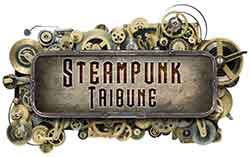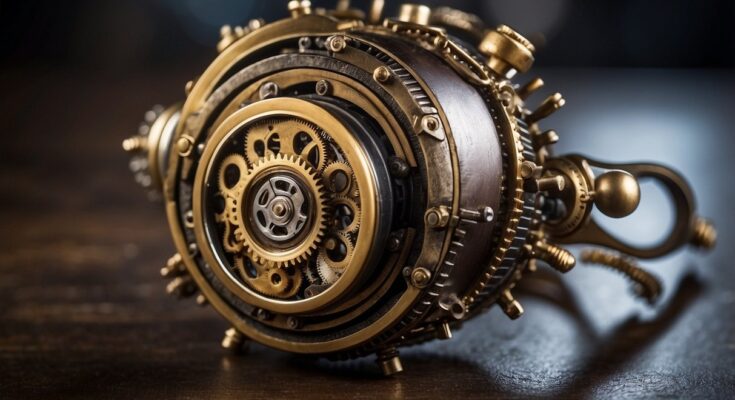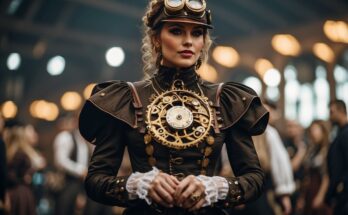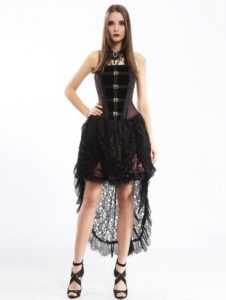Social media has significantly transformed the landscape of fashion, and steampunk is no exception. The vibrant community surrounding this genre has thrived on platforms like Instagram, Pinterest, and TikTok, allowing enthusiasts to share their creative interpretations and connect with like-minded individuals. The ability to showcase intricate designs and elaborate costumes through visual content has propelled steampunk fashion into a mainstream conversation.

Influencers and dedicated pages have played a crucial role in popularizing steampunk aesthetics, bringing attention to its unique blend of Victorian style and fantastical elements. Users curate their feeds to reflect steampunk ideals, creating a visual narrative that inspires others to embrace this unconventional style. As a result, social media not only boosts visibility but also fosters a sense of community among fashion enthusiasts.
The ongoing dialogue on social platforms has encouraged diversity within the steampunk subculture. Individuals can showcase personal adaptations of steampunk fashion, blurring the lines between traditional and modern interpretations. This exchange of ideas and inspiration keeps the genre fresh and welcoming, inviting newcomers to explore its rich possibilities.
The Emergence of Steampunk Fashion

Steampunk fashion has its roots deeply embedded in history and literature, inspired by the Victorian era. This style has evolved into a distinct subculture that celebrates 19th-century aesthetics while drawing from the worlds created by notable authors.
Historical Roots and Victorian Era Influence
The Victorian era, spanning from 1837 to 1901, was marked by rapid industrialization and technological advancements. This period inspired the steampunk movement, which incorporates elements of Victoriana such as corsets, top hats, and intricate accessories.
Victorian aesthetics emphasize craftsmanship and detail, characteristics fundamental to steampunk fashion. The fascination with steam power and machinery reflects an appreciation for the innovations of the 19th century. As a result, materials like leather, lace, and metals are commonly used, creating a blend of elegance and industrial ruggedness.
Literature: The Foundation of Steampunk Aesthetics
The literary contributions of authors like Jules Verne and H.G. Wells laid the groundwork for steampunk aesthetics. Their works often feature imaginative inventions and elaborate worlds, fueling the creative vision associated with this style.
Verne’s novels, such as 20,000 Leagues Under the Sea, showcase adventures driven by technology, inspiring the incorporation of nautical elements in fashion. Wells, on the other hand, introduces themes of time travel and alternate realities, which influence the whimsical aspect of steampunk attire.
This literary foundation encourages a narrative quality in steampunk fashion, where garments embody the spirit of adventure and exploration.
The Role of Steampunk Enthusiasts in Fashion
Steampunk enthusiasts play a vital role in shaping the fashion landscape. They not only embrace but also actively contribute to the movement by creating and sharing their unique interpretations of steampunk style.
Communities foster collaboration and showcase individual creativity through conventions and online platforms. This engagement has led to a diverse range of fashion expressions, from elaborate costumes to everyday wear featuring steampunk elements.
Enthusiasts often repurpose vintage items or incorporate modern pieces, emphasizing sustainability while remaining true to the aesthetic. The result is a thriving subculture that continually evolves while honoring its historical and literary roots.
Influence of Media on Steampunk Popularity

Media plays a significant role in shaping the popularity of steampunk fashion. It encompasses various forms, including film, television, literature, and video games, all contributing unique elements to the steampunk aesthetic and culture.
Steampunk in Film and Television
Films and television shows have been pivotal in introducing steampunk fashion to broader audiences. Productions like The League of Extraordinary Gentlemen showcase intricate costumes that emphasize Victorian ideals combined with futuristic technology.
Character designs often feature elements such as goggles, brass accents, and corsets, making these visuals iconic. Shows like Penny Dreadful further immerse viewers in steampunk settings, blending horror with adventure, which illustrates the versatility of this genre.
Literature and Media Interactions
Literature has long been a significant influence on steampunk trends. Works by authors like H.G. Wells and Jules Verne established foundational themes that resonate within the genre. Modern adaptations often highlight these themes while integrating contemporary technology, creating a dialogue between past and present.
Media interactions, such as adaptations of literary works into graphic novels, further expand the reach. Titles like Girl Genius exemplify how illustrations enhance storytelling, making it vivid and digestible for a diverse audience.
Video Games and Interactive Storytelling
Video games are crucial in bringing steampunk to life through interactive storytelling. Popular titles such as Bioshock Infinite and Dishonored feature richly designed worlds filled with steampunk elements. They allow players to engage with the fashion and aesthetics firsthand, creating a deeper connection.
Character customization options in these games often include steampunk fashion items, allowing players to express personal style. This interactive element helps solidify steampunk’s place in modern culture, merging technology with artistic expression.
Fashion Elements and Design
Steampunk fashion combines historical aesthetics with futuristic elements, creating a unique style that incorporates various materials and designs. Its distinctiveness lies in the blend of vintage and mechanical influences, expressed through specific apparel and accessories.
Distinctive Steampunk Apparel
Steampunk apparel often includes items such as corsets, waistcoats, and long flowing skirts. Brass buttons and lace accents frequently enhance garments, reflecting Victorian-era influences. Top hats are particularly significant, often embellished with gears or other mechanical elements. Fabrics like leather and velvet contribute to the rich texture and artistry of this style.
Layering is also a common technique; individuals might wear multiple pieces to create a visually dynamic outfit. Designers specializing in steampunk often pay close attention to craftsmanship, resulting in one-of-a-kind clothing that stands out in both casual wear and themed events.
Accessories: Goggles to Pocket Watches
Accessories play a vital role in defining steampunk fashion. Goggles are a quintessential element, symbolizing the fusion of technology and creativity. They may feature tinted lenses and brass accents, making them both functional and stylish.
Pocket watches are another iconic accessory, showcasing intricate designs with visible gears and steampunk motifs. Other popular items include metal jewelry and gadgets crafted from reclaimed materials.
The ingenuity in these accessories often reflects the wearer’s personality and creativity. They can turn a simple outfit into an intricate exploration of the steampunk aesthetic, allowing individuals to express their unique style.
The Influence of Technology and Innovation
Technology and innovation significantly impact steampunk fashion, as they inspire designs rooted in the imagination of a fantastical past. Many pieces integrate mechanical elements, evoking a sense of nostalgia for Victorian science fiction.
Gadgets often find their way into outfits as both functional and decorative elements. Designers creatively utilize materials such as Brass and leather to enforce the time-traveling narrative of steampunk.
Customization is also encouraged, allowing enthusiasts to adapt their fashion statements to reflect personal tastes and innovations. The blend of past and future connects to themes of craftsmanship and individuality, enhancing steampunk’s allure in contemporary culture.
Cultural and Social Impact
Social media has created platforms where steampunk enthusiasts can connect. This connectivity has fostered a sense of identity within the subculture. Its influence extends to community building, event organization, and mainstream acceptance in the fashion industry.
Subculture Identity and Community
Steampunk fashion thrives on shared aesthetics that merge the Victorian era with elements of technology and creativity. Through platforms like Instagram and Pinterest, enthusiasts showcase their unique outfits, featuring steam-powered machinery motifs. This visibility helps define individual identities while reinforcing a communal bond.
Online discussions and forums allow fans to explore steampunk history and its cultural significance. This engagement fosters a deeper understanding of the aesthetics involved and the innovation behind them. The community’s creativity is celebrated through user-generated content, highlighting personal interpretations of the style.
Steampunk Events and Conventions
Social media has revolutionized the way steampunk events are organized and publicized. Platforms facilitate the dissemination of event information, enhancing participation in conventions and gatherings. Notable events such as “The Golden Locket” in the U.S. attract large crowds, showcasing the thriving community.
These conventions serve as a hub where enthusiasts can share their passion for steampunk fashion. They feature panels, workshops, and cosplay competitions, allowing participants to immerse themselves in the culture. Social media often amplifies these experiences, as attendees post photos and updates in real time.
Mainstream Acceptance and Fashion Industry
As steampunk aesthetics gain traction, the fashion industry is responding to this growing interest. Influencers and designers illustrate how steampunk styles can be seamlessly integrated into contemporary clothing lines. High-profile collaborations often draw attention to the unique artistic vision embedded in steampunk designs.
Brands are beginning to adopt steampunk elements, from accessories to complete outfits. Fashion shows may feature steampunk-inspired collections, solidifying its place in the mainstream. This acceptance encourages new generations to explore and contribute to the aesthetics of the subculture.
The Art of Steampunk Fashion
Steampunk fashion combines historical elements with imaginative design, resulting in a unique aesthetic that captivates a diverse audience. Its influence derives from various artistic domains, including costume design, music, and craftsmanship.
Costume Design and Theatrical Influence
Steampunk fashion is characterized by intricate costume design that often draws from Victorian-era styles. The use of top hats, corsets, and layered outfits reflects a theatrical sensibility, evoking a sense of nostalgia and fantasy. Designers frequently incorporate clockwork mechanisms and metal accents, imbuing garments with a sense of innovation.
Costume events, such as conventions and themed parties, showcase these creations, providing a space for self-expression. The blending of punk aesthetics and goth elements further diversifies wardrobe choices, allowing individuals to convey personal narratives through their attire. This unique fusion of styles encourages creativity and individuality.
Music, Bands, and Steampunk Aesthetics
Music plays a vital role in shaping the steampunk aesthetic. Several bands incorporate steampunk themes into their performances, blending genres like folk, industrial, and rock. The music often features instruments that align with the steampunk ethos, such as violins and accordions, creating a captivating auditory experience.
Live performances often embrace steampunk visuals, enhancing the thematic experience. Costumes worn by musicians and their involvement in the community reinforce the interconnectedness of fashion and art. This synergy inspires fans to adopt similar styles, further promoting steampunk’s popularity.
Craftsmanship and DIY Ethos
The DIY ethos is a cornerstone of steampunk fashion. Artisans frequently create custom pieces, emphasizing craftsmanship and personal expression. Upcycling materials such as copper and metal is common, resulting in garments that reflect both creativity and a commitment to sustainability.
Workshops and online tutorials encourage individuals to experiment with their designs. This hands-on approach allows enthusiasts to construct unique items, fostering a sense of community among makers. The celebration of innovation and traditional crafting techniques enhances the allure of steampunk fashion, making it a vibrant and evolving art form.
Evolution and Future Directions
Steampunk fashion has undergone significant transformation driven by cultural influences and technological advancements. This evolution reflects a blend of imagination and innovation, shaping the aesthetics of both niche and mainstream fashion.
Integration with Other Fashion Trends
Steampunk fashion increasingly intersects with other styles, such as gothic, vintage, and cyberpunk. Designers incorporate elements like corsets, goggles, and mechanical accessories, allowing for a unique blend of historical and futuristic influences.
This integration enables creative expression while expanding appeal beyond dedicated steampunk communities. Social media platforms allow enthusiasts to share their interpretations, sparking trends that influence broader fashion landscapes. For instance, layered outfits combining steampunk with bohemian styles showcase versatility and individual flair.
The evolution illustrates how traditional aesthetics can adapt to contemporary sensibilities, emphasizing the importance of personal style in a rapidly changing fashion world.
The Role of Designers in Steampunk Evolution
Designers play a crucial role in the evolution of steampunk fashion. They reinterpret historical clothing through innovative techniques, creating pieces that resonate with modern sensibilities while honoring the genre’s roots. Many designers focus on storytelling through their creations, embedding narratives and character inspiration into their collections.
Collaboration among designers is fostering a community that highlights creativity and craftsmanship. Events and workshops allow emerging designers to showcase their talents, contributing to a dynamic and inclusive fashion scene. This continual reinvention ensures that steampunk remains a vibrant subgenre, drawing from the past while looking confidently towards the future.
Sustainable and Ethical Fashion Implications
As steampunk fashion evolves, sustainability and ethical considerations gain prominence. Many designers are shifting towards eco-friendly materials and practices, reflecting a growing consumer demand for responsible sourcing. Vintage or repurposed materials often feature prominently, aligning with the steampunk ethos of innovation through recycling.
Through social media, consumers increasingly engage with brands that prioritize sustainability, creating a strong incentive for designers to adopt ethical practices. This movement not only enhances the appeal of steampunk aesthetics but also encourages awareness of broader environmental issues within fashion. The future of steampunk fashion will likely emphasize sustainable innovation, ensuring a harmonious balance between creativity and responsibility.




